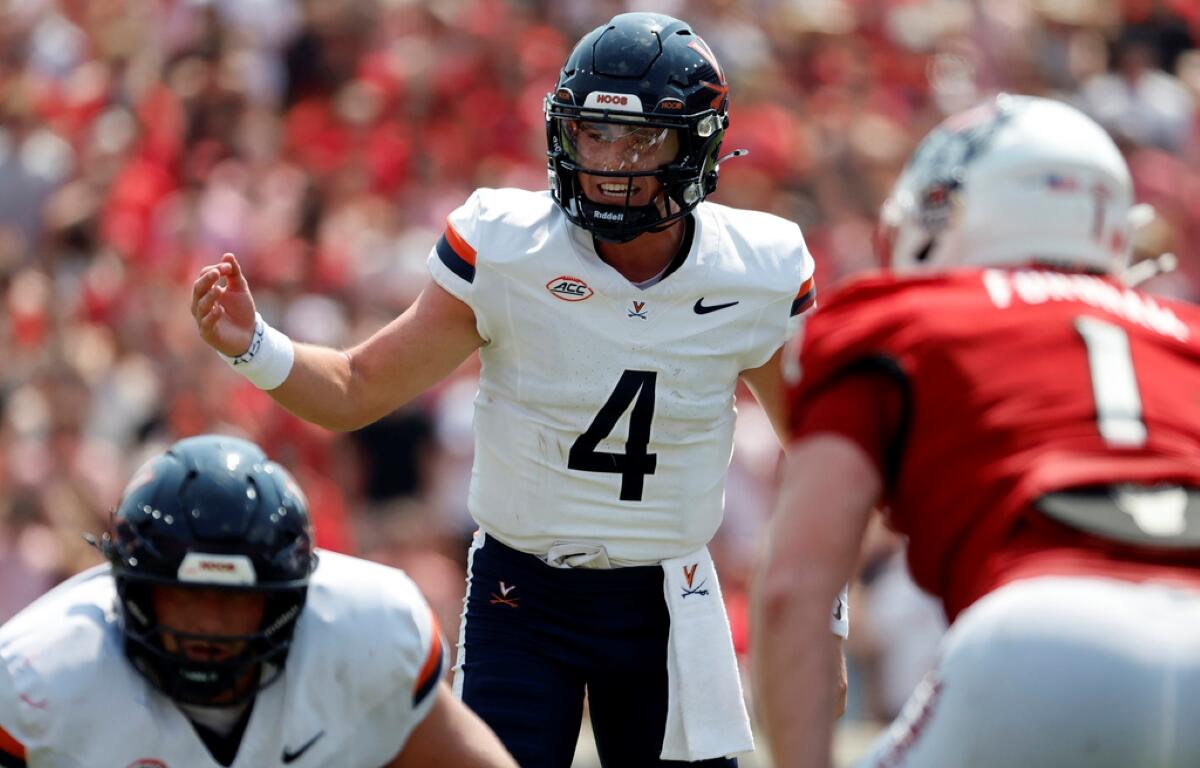CHARLOTTESVILLE, VA (CVILLE RIGHT NOW) – When Tony Elliott had recruited quarterback Chandler Morris – the son of a former coaching colleague – to play for Elliott at Virginia, Elliott had a clear picture of what he believed Morris could do for the Cavaliers.
Through his first five games in a UVA uniform, Morris proved Elliott correct, quarterbacking a record-setting offense that ranked second in the ACC in scoring and total yards. Morris was one of the conference’s most accurate and efficient passers.
The past two weeks, however, that offense has scuffled.
Virginia escaped Louisville with a 30-27 overtime win, getting a pair of defensive touchdowns, and snuck by Washington State on Saturday 22-20, with the game-winning points scoring on a safety by the defense.
“We’re going to get back to it,” UVA coach Tony Elliott said Tuesday during his weekly press conference as his No. 16-ranked team begins preparations for Saturday’s matchup against Bill Belichick and North Carolina.
And, despite Morris dealing with a left, non-throwing shoulder injury, Elliott is confident Morris will be a major catalyst for that return to form.
“Is Chandler going to be able to play at a high level? I believe he will,” Elliott said. “And hopefully it starts this week, but I believe he’ll be able to play at a high level.”
Morris’s production has dropped off the past two games, both narrow victories for Virginia (6-1, 3-0 ACC) that extended its winning streak to five.
Through the first five games of the year, he completed 71.6% of his passes, and averaged 255.8 passing yards per game. He threw for 10 touchdowns in those outings.
Over the past two games, against Louisville and Washington State, Morris has connected on just 60.7% of his throws, averaged 164 passing yards per game and tossed just one touchdown pass.
Both Elliott and Morris downplayed the significance of Morris’s shoulder injury.
Elliott said there were other factors – including injuries on the offensive line – to look at to diagnose the offensive issues.
“When you go back and watch the tape, I felt like the guys were playing hard, but we could have strained just a little bit more,” Elliott said. “And I think when you strain a little bit more, you capture some of the inches in the game. And I think that’s kind of what happened. And in the times where we did strain, we did what we needed to do. We found plays.”
Virginia expects to have both center Brady Wilson and left tackle McKale Boley back for Saturday’s game in Chapel Hill, N.C.
One possible factor in the drop-off was unavoidable. As the weeks have gone on, opponents have had more and more video to study of Virginia’s offense.
“Now everybody knows what this group is capable of,” Elliott said. “And so then we have to accept the challenge, which I’ve got full confidence in this group that they will.”
With transfers playing key roles at quarterback, running back, wide receiver and on the offensive line, the Cavaliers’ offensive strengths, weaknesses and gameplans were a bit of a mystery early on.
But as it piled up 539.6 yards and 45.6 points per game over its first five contests, going 4-1, it was also racking up information for opponents to study.
“At this point in the season, you’ve got a lot of film, a lot of tape on everyone,” Morris said. “They understand. There’s tendencies that everyone’s doing. At the end of the day, you just have to go out there and be yourself and do what you’re good at.”
So, why hasn’t Virginia been able to do that the last two weeks? In narrow wins over Louisville and Washington State, it has averaged just
269 yards per game. It totaled 52 points in those two outings, with two touchdowns and a safety coming from the defense.
The most obvious statistical difference has been UVA’s execution on third down and, subsequently, its time of possession.
The Cavaliers have gone just 11 for 30 on third down the past two games, the first two contests this season when they lost the time of possession battle.
“I think just staying in front of the sticks has been our biggest thing. Penalties. Negative plays on first down,” Morris said. “If we can just eliminate those, which is something we’re going to work on this week in practice, we can easily get that back on track.”
Against Louisville, that was certainly the case. UVA ran 22 first-down plays. It averaged just 1.9 yards per play. On 11 of those snaps, it gained zero yards or lost yardage.
That led to a dismal 6 for 15 showing on third down.
But against Washington State, Virginia was much more effective on first down. It snapped the ball 24 times on first down, and averaged
7.1 yards per play. It had just four first-down plays for zero or negative yardage.
Still, the Cavaliers went just 5 for 15 on third down against the Cougars.
Another factor, on first and third downs, has been the effectiveness of Virginia’s running game. After averaging 5.6 yards per carry over the first five games, that number has dipped to 3.3 in the past two outings.
Saturday, as UVA continues its quest for its first ACC title game appearance since 2019, it will face a defense that has been strong against the run. North Carolina (2-4, 0-2) is yielding just 3.4 yards per rush, the sixth best mark in the league.
“It’s just going back to playing our brand of ball,” Elliott said. “Staying ahead of the chains, being aggressive, playmakers making plays. So, we’re going to get back to that and I think that’ll kind of improve those areas.”



